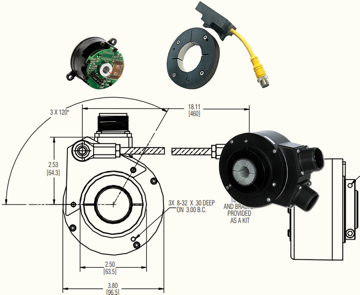What are the Advantages of a Bearingless Encoder?
Posted by London Rhodes on Feb 2, 2022 8:37:08 AM
What are the Benefits of Hubshaft Encoders?
Posted by London Rhodes on Feb 2, 2022 8:14:20 AM
Topics: How to Choose An Encoder, Installation
What are the Benefits of Shafted Encoders?
Posted by London Rhodes on Feb 2, 2022 8:01:54 AM
Topics: How to Choose An Encoder
What is a Hollowshaft Encoder?
Posted by London Rhodes on Jan 19, 2022 8:29:55 AM
Hollowshaft encoders allow the motor shaft to pass completely through and are secured by a shaft collar. This mounting style is easier to install and requires less space than a shafted encoder. Flexibility from the tether allows the encoder to float with the movement of the motor shaft, alleviating wear and tear on the bearings. The shaft collar is electrically isolated from the motor for protection against stray motor current.
What are the Encoder Mounting Options?
Posted by London Rhodes on Jan 19, 2022 8:14:21 AM
There are several types of encoder mounting styles to choose from when selecting an encoder for your application. Typically, you will choose between hollowshaft, shafted, hubshaft, and ring (or c-faced) mounting styles for encoders. Hollowshaft encoders allow the shaft of the motor to go through the encoder, and secures to the shaft by the shaft collar. Shafted encoders attach to the motor with a flexible coupling or possibly a belt (gear). Hubshaft encoders mount to motor shafts similarly to hollowshaft encoders. The difference in the hubshaft is that the motor shaft can only go about halfway into the encoder rather than completely through. Lastly, the ring (c-faced) option allows the encoder to bolt directly to the flange of the motor for bearingless designs. You will need to choose the mounting style that best suits your motor or application.
Topics: How to Choose An Encoder, Installation, Absolute Encoders, Optical Encoders, Magnetic Encoders
When Should You Use a Coupling to Mount Encoders?
Posted by London Rhodes on Jan 19, 2022 7:44:44 AM
Couplings also allow the encoder to compensate for shaft misalignment. Cutouts on the coupling allow flex to occur in the coupling rather than in the motor shaft. The runout from the shaft is absorbed by the coupling to prevent physical damage to the encoder.
Topics: How to Choose An Encoder, Installation, Troubleshooting
What is a Single- Ended Output?
Posted by London Rhodes on Jan 19, 2022 7:26:20 AM
How Do Reflective Encoders Produce a Signal?
Posted by London Rhodes on Sep 29, 2021 2:00:50 PM
How Do Magnetic Encoders Produce a Signal?
Posted by London Rhodes on Sep 29, 2021 1:58:27 PM
Magnetic encoders use a permanent magnet and a Hall Effect, or magnet resistive device, to produce a change in voltage or electrical resistance in the presence of ferromagnetic material. This change will occur in the form of a gear tooth (in a rotary encoder) or a metal band with slots (in a linear encoder). Tis type of sensor will work down to zero speed, and is available in both rotary and linear forms.
Topics: How to Choose An Encoder, Encoder Signals Output, Magnetic Encoders
How Does an Optical Encoder Produce a Signal?
Posted by London Rhodes on Sep 29, 2021 1:52:06 PM
Optical encoders use a glass disk with a pattern of lines deposited on it, a metal or plastic disk with slots (in a rotary encoder), or a glass or metal strip (in a linear encoder). Light from an LED shines through the disk or strip onto one or more photodetectors, which produce the encoder’s output. An incremental encoder has one or more of these tracks, while an absolute encoder has as many tracks as it has output bits.
Topics: How to Choose An Encoder, Encoder Signals Output, Optical Encoders
